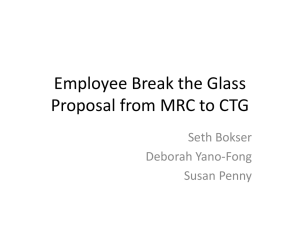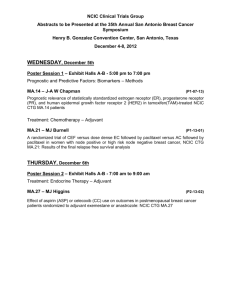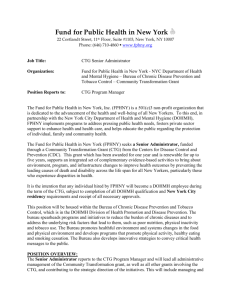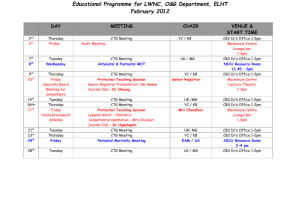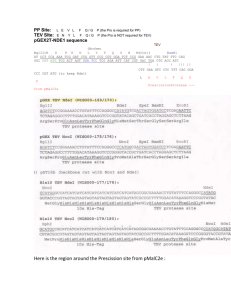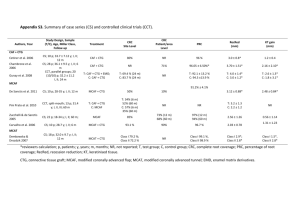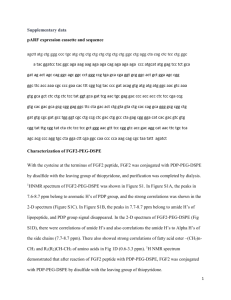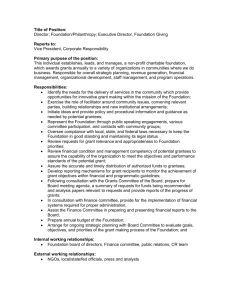CTG Grantees: Frequently Asked Questions
advertisement
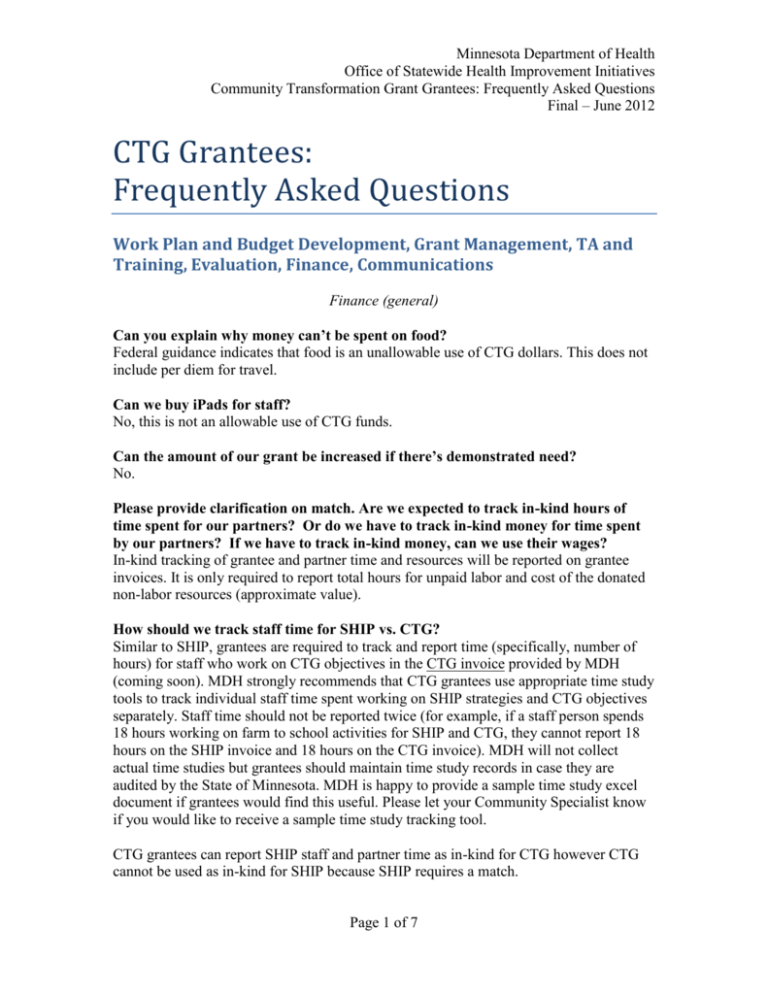
Minnesota Department of Health Office of Statewide Health Improvement Initiatives Community Transformation Grant Grantees: Frequently Asked Questions Final – June 2012 CTG Grantees: Frequently Asked Questions Work Plan and Budget Development, Grant Management, TA and Training, Evaluation, Finance, Communications Finance (general) Can you explain why money can’t be spent on food? Federal guidance indicates that food is an unallowable use of CTG dollars. This does not include per diem for travel. Can we buy iPads for staff? No, this is not an allowable use of CTG funds. Can the amount of our grant be increased if there’s demonstrated need? No. Please provide clarification on match. Are we expected to track in-kind hours of time spent for our partners? Or do we have to track in-kind money for time spent by our partners? If we have to track in-kind money, can we use their wages? In-kind tracking of grantee and partner time and resources will be reported on grantee invoices. It is only required to report total hours for unpaid labor and cost of the donated non-labor resources (approximate value). How should we track staff time for SHIP vs. CTG? Similar to SHIP, grantees are required to track and report time (specifically, number of hours) for staff who work on CTG objectives in the CTG invoice provided by MDH (coming soon). MDH strongly recommends that CTG grantees use appropriate time study tools to track individual staff time spent working on SHIP strategies and CTG objectives separately. Staff time should not be reported twice (for example, if a staff person spends 18 hours working on farm to school activities for SHIP and CTG, they cannot report 18 hours on the SHIP invoice and 18 hours on the CTG invoice). MDH will not collect actual time studies but grantees should maintain time study records in case they are audited by the State of Minnesota. MDH is happy to provide a sample time study excel document if grantees would find this useful. Please let your Community Specialist know if you would like to receive a sample time study tracking tool. CTG grantees can report SHIP staff and partner time as in-kind for CTG however CTG cannot be used as in-kind for SHIP because SHIP requires a match. Page 1 of 7 Minnesota Department of Health Office of Statewide Health Improvement Initiatives Community Transformation Grant Grantees: Frequently Asked Questions Final – June 2012 Evaluation Can you clarify the responsibilities for MDH vs. grantees for evaluation? Who is responsible for data collection, entering, and analysis? If we’re contracting with an outside evaluator, what can we expect them to do? Further clarification regarding CTG grantee and MDH evaluation roles and responsibilities will be presented at the first CTG Evaluation Training Webinar on Tuesday, June 19, 2012, from 1:00-2:00 PM. All CTG grantee program managers, evaluation staff and evaluation contractors should attend this webinar. Information regarding this webinar is listed below. A reminder about it will be sent out by your Community Specialist a week before the webinar as well. CTG Evaluation Webinar o Agenda: General overview of MDH’s CTG Grantee Reporting and Monitoring responsibilities around reach and cost study; plans for evaluating Clinical Services and Healthy Eating interventions; options for evaluating Active Living and Tobacco-Free Living Strategies. o Link o Password: CTGeval2012! o Call-in info: 1-888.742.5095, Code: 228 338 7811 Will estimated reach need to be unduplicated? With SHIP? Within CTG, across settings? Further guidance on how to collect and document reach for the CTG grant versus the SHIP grant will be outlined by the MDH evaluation team once CDC has provided their guidance for CTG reach measurement. An update will be provided at the first CTG Evaluation Training Webinar on June 19, 2012, Tuesday, from 1:00-2:00 PM, listed above. Communications Are you going to create a new logo for CTG? What logo will we need to use (SHIP, CDC, etc.)? No new logo will be created for CTG. Please use the SHIP logo and follow the SHIP logo guidance on our website. We have not received any guidance from CDC about being required to use their logo. So, at this time, there is no need to use it. Grant Management & Work Plan and Budget Development Will we be expected to complete a budget narrative to accompany our budget? Yes. You should have received budget narrative instructions via email from your Community Specialist. If you have not, please contact your Community Specialist to receive it. Page 2 of 7 Minnesota Department of Health Office of Statewide Health Improvement Initiatives Community Transformation Grant Grantees: Frequently Asked Questions Final – June 2012 Will we be revising our budget and work plans if we no longer have SHIP funding after 2013? A lot can happen over the course of this 5-year grant. We anticipate that work plans and budgets will have to be revised from time to time as priorities, funding streams and other factors change. For now, we encourage you to develop your work plans with what you know today. So, please develop them knowing that you have SHIP funding through June 30, 2013. Can we start implementing our work plans and spending money now or do we have to wait until they are finalized? Yes, however, please contact your Community Specialist for approval before you begin implementing initial steps in your work plans and spending the money. Can MDH provide guidance / ideas for how can we spend money quickly (for year one)? 1. Execute contracts 2. Conduct evaluation activities – needs assessment, survey development 3. Hire or re-deploy existing staff to support strategies 4. Implement work plan activities Other What is the time frame for the official appointments for the statewide leadership team? Our plan is to have MDH’s Executive Leadership Team make the appointments the last part of June 2012 with the first meeting of the statewide leadership team scheduled no later than mid-August 2012. How was the data decided upon to use in the maps and information in the packets given to us at the CTG kick-off meeting? We looked at existing data sources to highlight chronic disease disparities by county and to highlight poverty at the census block level. Data sources are indicated at the bottom of each map. The “concentrated poverty” tracts were identified using the methods described in a report from the U.S. Census Bureau entitled “Areas with Concentrated Poverty: 2006-2010—American Community Survey Briefs.” The report can be found at: http://www.census.gov/prod/2011pubs/acsbr10-17.pdf. All tracts listed have poverty in Categories II, III, or IV, which is 13.8% of residents or higher (see page 2 of the report). The State Demographic Office lists the % in poverty for all Census tracts in Minnesota. See http://www.demography.state.mn.us/resource.html?Id=32559. Page 3 of 7 Minnesota Department of Health Office of Statewide Health Improvement Initiatives Community Transformation Grant Grantees: Frequently Asked Questions Final – June 2012 Healthy Eating What does access to healthy food mean? For the purposes of this grant, healthy food is defined as any fruit or vegetable and other foods that are low in sugar, saturated fat and sodium. Access is defined as the process of selecting, purchasing, carrying home, preparing and consuming healthy food. What is a healthy food access plan? This generally includes plans to: a) Assess the barriers to accessing healthy foods b) Determine what strategies will be used to decrease the barriers and improve healthy food access c) Action steps outlining the work d) Evaluate the work What kind of work is expected with schools? Improve any access to healthy foods outside the national school lunch program. Minnesota Department of Education (MDE) will be responsible for training on the new meal standards for the National School Lunch Program (NSLP). Training and support by public health such as Farm to School, purchasing, knife skills, salad bars, competitive foods etc. are acceptable. Any training on the NSLP menu planning can only be done by the School Food Authority (SFA) or their designee. In MN, the SFA is MDE. Tobacco Can ID scanners be purchased or can we pay for compliance checks with CTG funds? No, ID scanners are not an allowable CTG expense and the expenses associated with conducting municipal compliance checks should be incorporated in the local license fee. The rationale for this is that the CTG strategies are aiming to create PSE change that enhances or improves the tobacco ordinance. If there are insufficient funds to conduct compliance checks of licensed retailers, then a CTG strategy could include updating the ordinance to increase the price of tobacco retail licenses to pay for the program. In addition, using CTG to pay for compliance checks would only temporarily fix the problem versus a sustainable change. Can we work on restricting tobacco sampling (hookah)? Yes. CTG grantees are allowed to work on restricting tobacco sampling such as Hookah at dedicated tobacco retail tobacco stores. It is important to first identify if tobacco sampling is occurring in local businesses and/or if the businesses primary purpose is to provide a place for customers to smoke. If the primary purpose is to provide a dedicated indoor smoking lounge, the business may be in violation of the Minnesota Clean Indoor Air Act and the CTG grantee should contact the Minnesota Clean Indoor Air Unit. While Page 4 of 7 Minnesota Department of Health Office of Statewide Health Improvement Initiatives Community Transformation Grant Grantees: Frequently Asked Questions Final – June 2012 the MCIAA does contain a provision that allows customers or potential customers to light tobacco in dedicated retail tobacco stores, “for the specific purpose of sampling..” this exemption does not apply to dedicated smoking lounges. For more information on the MCIAA, go to: http://www.health.state.mn.us/freedomtobreathe/ Will MDH or TA providers help navigate the nuances between smoke-free licensed foster care policies and family placements? Yes, the MDH staff will be able to assist CTG grantees. The Public Health Law Center (PHLC), a CTG TA provider, is a great resource to help you address this difference. They recently produced two documents and PowerPoint presentations on smoke-free foster care which can be found on their website at: www.publichealthlawcenter.org. Can/should we use subcontractors to conduct community and environment assessments? Yes, this is definitely an options for grantees. Please build this cost into your budget and communicate this to your Community Specialists, if this is your intention. If we are already working on smoke-free MUH with SHIP funding, are we required to do the smoke-free housing strategy under CTG too? Yes, CTG grantees are required to work on the smoke-free housing strategy. The CTG funds are to be used to build upon your local smoke-free multi-unit housing SHIP 2.0 efforts by including all types of rental housing and garnering regional partnerships. The SHIP 2.0 MUH targeted populations are similar to CTG targeted populations. However, CTG has a special focus on the mental health and low socioeconomic populations. CTG also includes all rental/transitional/temporary housing and adds a new level of PSE change by creating larger, more population-based, PSE change. PSE change addressing these populations across a region is a high priority. The idea is that higher impact, population-based changes do not happen in a silo, but through a regional movement. CTG Regional Targets Large management companies/owners serving low socioeconomic communities across the north • Temporary/transitional housing shelters (homeless, mental health, substance abuse) Development companies Organizations who provide housing re/development grants Subsidized housing funders Public housing and redevelopment authorities Changes to rental housing licensure or inspections Required smoking disclosure by landlords Page 5 of 7 Minnesota Department of Health Office of Statewide Health Improvement Initiatives Community Transformation Grant Grantees: Frequently Asked Questions Final – June 2012 Health Care Can the grant pay for IT and report-building in electronic health records? No, the grant will not be able to cover technology costs for specific clinics or health systems. MDH is contracting with Stratis Health who will be doing an HIT assessment on clinic partners. The grant may be able to cover some clinic staff time to pull baseline data from the electronic health records. This will be determined on a case by case basis. How many chart audits do you require? It is recommended that each program develop a chart audit policy and procedure that describes the criteria for the audit, frequency of audits, and the steps to choose the charts to be audited including the number of charts. Clinics generally have a chart audit policy in place so staff should check with each clinic/organization. The MDH SHIP website has tools available to create a chart audit policy and procedure. http://www.health.state.mn.us/healthreform/ship/implementation/healthcare/counselingto ols/chartfaq.pdf Minnesota Community Measurement (MNCM) has a recommended random sample selection procedure that clinics may be familiar with. See page 28 in the following document http://mncm.org/site/upload/files/Optimal_Diabetes_Care_2012_DDS_FINAL_12.13.20 11.pdf Do you have criteria to use for the RFP process in deciding which clinics to work with? MDH recommends the following criteria: clinic’s level of readiness, leadership support, commitment to implementing SHIP’s 2.0 preventive health process, and clinic is a certified health care home or safety net clinic. It is expected that CTG grantees will work with MDH/OSHII and Stratis Health in choosing a community and clinic to work with for the clinic-community resource component. Where can we find the Hennepin County SHIP Health reports? On the MDH website there is a resource page for SHIP grantees that provides SHIP 2.0 guidance and tools for implementation. You can access the Hennepin County/Minneapolis SHIP reports from this link under “SHIP Health Care Provider Toolkit for Obesity and Chronic Disease Prevention.” Page 6 of 7 Minnesota Department of Health Office of Statewide Health Improvement Initiatives Community Transformation Grant Grantees: Frequently Asked Questions Final – June 2012 Active Living Can we contract directly with the Regional Development Organizations (RDO)? No. MDH is contracting directly with the RDC’s and WCI at this time to conduct CTG projects. The intent is to establish a solid relationship between the State, regional partners, and local public health. This process should help strategically align all partners and will not interfere with relationships that have already been formed. If it makes sense to consider an alternative contractual relationship in future years, MDH will be willing to discuss options that make sense for all parties. Any existing non-CTG contractual relationships between the grantee and RDOs are perfectly fine to maintain, for example contracts funded through SHIP. Page 7 of 7

